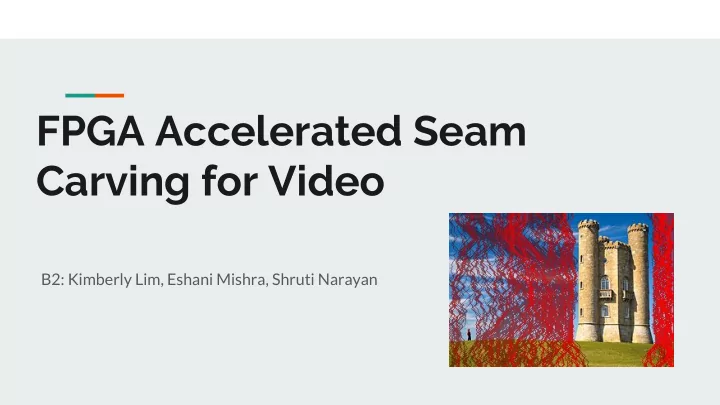

FPGA Accelerated Seam Carving for Video B2: Kimberly Lim, Eshani Mishra, Shruti Narayan
Use Case Scale Crop Seam Content-aware re-scaling takes into account features within the frame, and intelligently targets parts of the frame to remove or interpolate during the re-scaling process. Computational complexity becomes the bottleneck of the implementation of the algorithm. A hardware-oriented seam carving algorithm using FPGA is proposed to improve performance. ECE Areas: Hardware (FPGA), Software (Seam Carving Algorithm)
Requirements - Resize video for different display sizes, while maintaining important content integrity - Video processing on FPGA with a 10x speedup over using only software processing - Static seams: most useful when the camera is stationary, and the foreground and background are separated - Access and process user uploaded videos with a maximum resolution of 480p x 360p with a max length of 5 seconds at 30fps through microSD card - Convert processed video into viewable format on the monitor by converting from binary to .bmp file
Potential Extensions - Forward Energy - Adding Seams (make videos larger) - Process videos taken with FPGA camera - Object/face detection Input - Graph cut: useful for videos with moving subjects or a moving camera (out of scope due to memory constraints ) Forward energy No forward energy
Technology - DE2-115 FPGA board (for computation) - OV7670 CMOS camera (to interface with board and provide live video) - Monitor (for projection) - HDMI cable (FPGA connection to monitor) - Micro SD card (storing video files) - Raspberry Pi (conversion of .bmp to .hex file; potentially for post-processing of output into viewable format)
Solution Approach - User can upload videos to a library which our system will be able to access (to SD card) - Read pictures to the FPGA from stored files on SD-card using pre-processed images that’s been converted to proper format (binary) - Preprocess video data for use in the algorithm - Based on traditional seam carving, the algorithm can be divided into 3 steps (sequential) - We will modularize this part of the project based on those 3 steps and remove static seams - Video carving with a speedup over using only software processing - Speedup would be achieved through parallel processing capabilities of the FPGA, as well as eliminating latency from using interpreted languages - Convert processed video into viewable format on the monitor
FPGA Memory Utilization - Rough time estimate for algorithm: 30 cycles per pixel = 6*10^-7 s ~ 1 μ s per pixel - 5 second Youtube 360p video has 480 by 360 pixel resolution, 30fps - FPGA has 3,080,000 bits for memory - Spatial map is the most time/space consuming operation in the algorithm - Without parallelization: - 480 * 360 * 6* 10^-7 s/pixel * 30 fps * 5s = 15.552 seconds per seam - Parallelize the work by row - make groupings of each cell in the row and surrounding 8 and copy into RAM - 360 pixels/row * 9 pixels* 8 bits/pixel = 25,920 bits (much more space left on FPGA - can parallelize more rows) 480 rows * 6* 10^-7 s/pixel * 30 fps * 5s = 0.0432 seconds per seam - - Other proposed blocking methods to explore - Parallelize more rows at a time
Testing + Meeting Requirements Video resizing of different Compare our implementation to videos to display sizes those presented in research paper of the algorithm Speedup of processing on Benchmark energy-map computation FPGA implemented C and compare to our FPGA using cycle counts Static Seam removal Identify all important features in test videos and print viewable seam lines on frames to ensure most important features are being preserved Convert processed video into Third party independent tester for verifying human-viewable format video output matches resolution
Verification - Meets use cases and customer needs if: - Our final video preserves content better than alternative cropped, scaled, or low resolution versions - Performs at least 10x faster than software solution - Resizes video to correct resolution without distorting important features in the video (improvement over running the algorithm separately over every frame) - Resized video is viewable on monitor
Metrics Quality Compare to frame by frame of baseline. Identify objects of importance in video and analyze level of distortion after resizing Utility Must be able to Metric Performance process any user Compare time to supplied video within open software (both scope requirements interpreted and and remove the compiled) desired amount of seams
Tasks + Division of Labor ● BMP to HEX file Preprocessing of data Eshani Load Image into FPGA ● ● Spatial & temporal energy map Shruti ● Accumulation matrix with weights System & Algorithm Design Kim Path-sum calculation and min ● Eshani ● Min-seam removal ● Files for energymap, pathsum, main Shruti ● restitch of video for next seam System Implementation Kim ● Top module to repeat steps ● Conversion from HEX to BMP ● Write result to SD Eshani Post processing of result Display result to monitor ●
Schedule
System Diagram SD Card FPGA SD Card Monitor 1 5-second-video of 30 Read binary files from Store post-processed Use HDMI or VGA on fps is converted to 150 SD card and process frames in SD card due FPGA to output images of the same video frames to memory limit of processed-video. resolution. (1 .mp4 file according to algorithm FPGA. At end of -> 150 .bmp file) program, all result frames are on SD card. Convert each .bmp to 150 .hex files .hex file and store into post-processed SD card
Recommend
More recommend